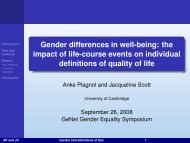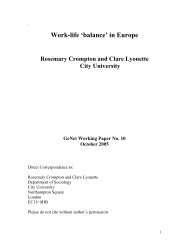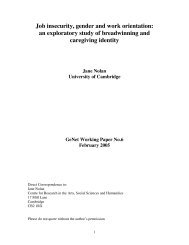Guidelines for Gender Equality Programmes in Science - GeNet
Guidelines for Gender Equality Programmes in Science - GeNet
Guidelines for Gender Equality Programmes in Science - GeNet
You also want an ePaper? Increase the reach of your titles
YUMPU automatically turns print PDFs into web optimized ePapers that Google loves.
Executive Summary<br />
An endur<strong>in</strong>g pattern<br />
The difficulty women have <strong>in</strong> reach<strong>in</strong>g leadership positions is so systematically widespread <strong>in</strong><br />
all spheres of social life that it appears to be a deeply rooted pattern reproduc<strong>in</strong>g itself even<br />
<strong>in</strong> the most advanced societies. Public attention has largely focused on women’s under-representation<br />
<strong>in</strong> politics, bus<strong>in</strong>ess or public adm<strong>in</strong>istration, while the existence of gender bias <strong>in</strong><br />
science and technology has long been underrated or even denied. This has, <strong>in</strong> all likelihood,<br />
contributed to the supposed gender-neutrality of science, <strong>in</strong> turn based on an assumption that<br />
considers science a rational activity which is thus hardly “polluted” by the social and cultural<br />
dynamics produc<strong>in</strong>g gender discrim<strong>in</strong>ation.<br />
Un<strong>for</strong>tunately, science is no exception, and the data clearly show this. In Europe, North<br />
America and elsewhere, women tend to disappear as we progress from lower to higher levels<br />
of scientific careers. In EU-member states, women hold fewer than 20% of all higher academic<br />
positions (grade A), despite the fact that they account <strong>for</strong> over 55% of all university students<br />
and <strong>for</strong> nearly 60% of all graduates. Although <strong>in</strong>creases <strong>in</strong> women’s presence <strong>in</strong> highly<br />
qualified positions are regularly reported, their actual pace is slow (about a 2% <strong>in</strong>crease <strong>in</strong><br />
women’s presence <strong>in</strong> grade A positions over 5 years).<br />
Yet, women’s participation <strong>in</strong> research is not the only issue at stake. It mirrors a broader and<br />
deeper lack of recognition of the gender dimension of science, affect<strong>in</strong>g its contents, methods<br />
and priorities. This has <strong>in</strong>creas<strong>in</strong>gly negative impacts on research quality, research policies<br />
and on the use of scientific results <strong>in</strong> economic and social terms.<br />
Policy ef<strong>for</strong>ts<br />
Fortunately, the significance of these issues has been grasped by many <strong>in</strong>stitutions and players,<br />
both <strong>in</strong> Europe and <strong>in</strong> other parts of the world, lead<strong>in</strong>g to <strong>in</strong>creas<strong>in</strong>g commitment to gender<br />
equality <strong>in</strong> science.<br />
Many national governments have developed various measures to <strong>in</strong>crease women’s participation<br />
<strong>in</strong> science and technology (S&T). S<strong>in</strong>ce the mid-1990s, the European Commission has<br />
greatly developed its actions <strong>in</strong> this regard, <strong>in</strong>clud<strong>in</strong>g an ever-broader array of different <strong>in</strong>itiatives<br />
and measures. In this changed environment, many universities, research <strong>in</strong>stitutions,<br />
professional networks and women’s associations have designed and developed projects<br />
focus<strong>in</strong>g on gender equality <strong>in</strong> S&T.<br />
3






